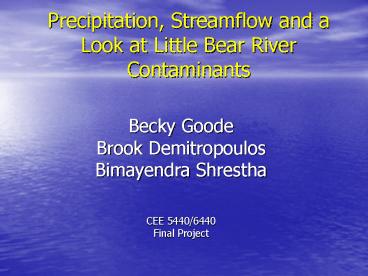Location of Weather Stations - PowerPoint PPT Presentation
1 / 30
Title:
Location of Weather Stations
Description:
Precipitation, Streamflow and a Look at Little Bear River ... below Porcupine. 8. Davenport abv S. Fork. 8. above Davenport Crk % of Samples Non-supporting ... – PowerPoint PPT presentation
Number of Views:41
Avg rating:3.0/5.0
Title: Location of Weather Stations
1
Precipitation, Streamflow and a Look at Little
Bear River Contaminants
Becky Goode Brook Demitropoulos Bimayendra
Shrestha CEE 5440/6440 Final Project
2
The Hydrologic Cycle
3
The Main Focus of Our Project
- Determine and analyze the relationship that
exists between - Precipitation
- Streamflow
- Look at contamination in the Little Bear River
4
Simplified Process
- Looking only at precipitation and streamflow
- Infiltration and Snow melt are not considered
5
Study Area Little Bear Logan
6
Location of Weather Stations
7
Weather Station locations on the Little Bear
Logan Watershed
8
Long-term Precipitation in Little Bear-Logan
(inches)
9
Area Average Precipitation
- Thiessen Polygon Method
- Associates each point in the watershed with the
nearest weather station - Produces a table providing the number of grid
cells in the watershed associated with each
weather station
10
Area Average Precipitation
11
Area Average Precipitation
- Calculation of Average Area Precipitation
- Join thiessen grid table with weather station
table - Use the equation
- Count Number of grid cells associated with each
weather station
12
Long-term Average Precipitation in Little Bear -
Logan
13
Streamflow Gauging Stations
14
Location of Streamflow gauges
15
(No Transcript)
16
Daily Streamflow based on 83 years of record
17
Long time average Monthly Streamflow (cfs)
18
Long time average Streamflow data (inches)
19
Average Precipitation and Streamflow
20
Runoff Ratios
- Average Yearly Streamflow / Average Yearly
Precipitation the runoff ratio
21
POLLUTION CONCERNS IN LITTLE BEAR RIVER
Reference Little Bear River Watershed TMDL, Utah
Department of Environmental Quality
22
Land Use
23
Cropland
24
Major Environmental Problems
- Sediments
- Nutrients
- Erosion
- Runoff from dairies, feedlots and irrigated
croplands - Poor riparian conditions
- Degradation of Hyrum Reservoir
- Degraded stream channels and stream banks
25
Little Bear River Watershed TMDL
- Total Maximum Daily Load
- The Maximum amount of a pollutant that a
waterbody can receive and still meet water
quality standards - Goal is to meet state water quality standards for
the designated beneficial uses of the waterbody - Determined by the state
- Takes into account the use of the waterbody such
as drinking, contact recreation, aquatic life
support, irrigation etc
26
State Beneficial Use Classification
27
Little Bear River Beneficial Use Classification
- Classification 2B
- Protected for secondary contact recreation such
as boating, wading - Classification 3A
- Protected for cold water species of game fish
and other cold water aquatic life - Classification 3D
- Protected for waterfowl, shore birds and other
wildlife - Classification 4
- Protected for agricultural uses including
irrigation of crops and stock watering
28
Calculation of Flow
- The concentration of contaminants depends on the
flow in the river - For point source contaminants does not vary with
the flow rate - However, non-point source contaminants input is
greatest during high flow runoff periods. - Which flow to use?
29
Water Quality Indicator Phosphorus (max allowed
0.05 mg/l)
30
Steps for improvement
- Streambank stabilization
- Riparian rehabilation
- Animal waste management
- Point source control
Reference Little Bear River Watershed TMDL, Utah
Dept of Environmental Quality































